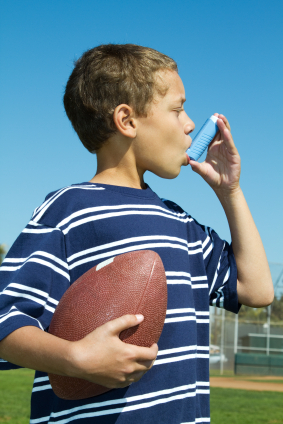
With its high pollen counts, increased humidity, and air pollution, summer is asthma season. Approximately 34.1 million Americans have been diagnosed with asthma during their lifetime, and the number of people with asthma will grow by more than 100 million by 2025.
Here are some common asthma myths and tips parents can take to prevent asthma
attacks.
Myth: There aren't that many people with asthma; it's just a bunch of media hype.
Facts:
- In the 1990s, more than 7.1 million people visited physicians for asthma conditions and more than 3,300 people died from asthma during this time.1
- Today, an estimated 34.1 million adults and 9 million children, under the age of 18, suffer from lifetime asthma in the United States.2
- According to the American Lung Association, over 500,000 people are hospitalized each year, and there are more than 5,500 asthma related deaths annually.
Myth: Asthma is all in your head-get counseling and get over it.
Facts:
-
There are two types of asthma.3
-
Allergic (extrinsic) Asthma is triggered by an allergic reaction to an inhaled substance such as dust, pollen, mold, chemicals, animals, etc. 90 percent of asthma cases are caused by extrinsic asthma.
- Non-allergic (intrinsic) Asthma is triggered by factors not related to allergies such as exercise, anxiety, depression, cold air or dry air, etc. The symptoms of both are the same: coughing, wheezing, shortness of breath, rapid breathing, and chest tightness.
-
- Either type of asthma can be life threatening. It is unlikely that psychotherapy will correct asthma triggered by an allergen or cold air.
Myth: If you relax and don't over-react every time you feel shortness of breath, then you won't have an asthma attack.
Facts:
- For many people afflicted with asthma, it can feel similar to drowning. The smooth muscles around bronchial tubes tighten up and become inflamed, thus causing a further narrowing of the tubes. At the same time, the lungs produce excess mucus, filling up the narrowed spaces where air should be flowing. In turn, oxygen levels decrease in the blood.4 This indicates a biological reaction that isn't allowing proper breathing and oxygenation in the body.
Myth: If we didn't coddle our children, there would be less asthma.
Facts:
Some people are born with a predisposition toward developing asthma. However, what actually triggers the disease can vary from person to person. Common triggers include:
- Tobacco and smoke
-
Studies show that children whose parents smoke are twice as likely to develop asthma as children of nonsmoking parents. Also, children whose mothers smoked during pregnancy tend to be born with smaller airways, which greatly increase their chances of developing the disease.
-
- Pollen
- Allergens from animals and insects
- Abrupt weather changes
- Biological contaminants such as mold, and viral infections.
- Prescription drugs and over-the-counter medications such as blood pressure drugs, aspirin, acetaminophen and ibuprofen are all known asthma triggers.5
Myth: The proper way to treat asthma is through medication and immunotherapy (desensitization shots).
Facts:
- Asthma doesn't have to severely limit one's life. During an acute severe asthma attack, inhalers or a trip to the emergency room may be appropriate, but there are steps to take that can prevent asthma and avoid asthma attacks.
-
Natural Solutions to Asthma and Breathing Problems include:
-
Keep your child away from those who smoke.
-
Keep home humidity levels between 30 to 50 percent. High humidity levels can promote the growth of mold which can trigger allergic (extrinsic) asthma.
-
Install high-efficiency furnace filters and replace them monthly. If using electrostatic furnace filters, clean them monthly,
-
Although it's impossible to keep a house free from mold, dust, dust mites, fungus and dirt, use allergen-proof mattress covers and pillowcases to help minimize allergens.
-
Use a high-efficiency vacuum cleaner and empty its contents outside.
-
Keep pets out of the bedrooms of family members with asthma.
-
Clean the drapes often.
-
Be aware of your child's reactions to foods. The most common asthma triggering foods are grains, dairy, corn, soy and various flours.
- Find out about AAT (Advanced Allergy Therapeutics), and get your child on the road to recovery.
-
The Biggest Myth: Your child will always have to avoid asthma triggers for the rest of his life
Facts:
- No one can guarantee that any allergy treatment will work, but there is a way to treat the symptoms associated with allergies and sensitivities that trigger asthma by reducing the biological stress caused by the offending substances. This reduces asthma episodes and allows a person with asthma to lead a more normal lifestyle.
- Advanced Allergy Therapeutics (AAT) retrains the body so that it no longer reacts inappropriately when in contact with an offending allergen.6] The AAT treatments do not rely on the use of needles, medications, homeopathy, herbal remedies or supplements.
1. Asthma In America, Asthma Statistics; National Institutes of Health, National Heart, Lung, and Blood Institute Data Fact Sheet, Asthma Statistics.
2. http://www.nsc.org/news_resources/Resources/Documents/Asthma.pdf
3. http://www.asthmasymptom.org/asthma-type.html
5. http://www.asthmasymptom.org/acute-asthma.html
6. http://www.midwestallergyrelief.com/faq.htm
Ian Wahl, DAc, LAc, CH is a Doctor of Acupuncture and herbalist who specializes in the treatment children and adults with allergies and hypersensitivities. He is the Founder and Director of the Midwest Allergy Relief Center as well as the Wahls of Wellness. Dr. Wahl can be reached at 847 392-7901 or info@MidwestAllergyRelief.com.
Created July 16, 2010








